Here it is! I'm thinking the bling on the masquerade masks might not have been a good idea, but oh well. The intention was to coordinate the level of decoration with the likelihood I would present a false sense of self to that particular social sphere.
Artist's Statement:
For this project, I wanted to keep things simple. In sorting through the pile of junk paper on my desk, I realized that I could separate the papers into different social spheres--school, church, and dance. Each social sphere represented a different part of me, or a different "mask" that I put on each day. I like the idea of creating physical masks to represent people's personas, and decided that the level of decoration would represent how false a sense of self they are likely to show a particular social sphere. In the end, the masks ended up being almost the same in level of decoration, which shows my realization that in changing even just a small part of your personality in identity in order to fit in, you end up changing your entire sense of self. Finally, the journal face represents people at their core. Undecorated and unadorned, I modeled the journal mask off my own face, so it has all the imperfections that I have. Nothing is hidden. The journal pages contain entries that highlight the confusion and hurt and depression that I worked so hard to cover up for over a year. No more hiding, no more masquerade.
Tuesday, February 22, 2011
Monday, February 21, 2011
Featured Artist: Ron Mueck
on Mueck began his career as a puppet and model maker for movies, eventually moving on to create animatronics and models for advertisements. These models dissatisfied him because they were created only to be seen from one angle. Anything beyond the camera frame could be a complete mess. Wishing to create figures that had "a presence" he turned to sculpture where he began constructing human figures in incredible detail.

Mask II, 2001-2002
Pregnant Woman (close up), fibreglass, resin, silicone, 2002
One of the aspects of Mueck's work is the way he plays with scale. Despite his figures being incredibly realistic, most of his pieces are either much larger or much smaller than real life. He once said "I never made life-size figures because it never seemed to be interesting. We meet life-size people every day."

A girl, 2006

Spooning Couple, 2005
Many of Mueck's works tell subtle stories such as Spooning Couple, which shows a tiny man and woman laying together, the man in a T-shirt and the woman in a pair of underwear. The understated emotion is reflected in the miniature figures.There is no sign of obvious antagonism yet things do not seem to be completely alright. Their expressions and the fact that they both have their eyes open yet are not looking at each other hint that we are witnessing the moment where sexuality evaporates.
All in all, Mueck's work is a fascinating display of dedication to detail and the study of the human form.

In Bed, 2005

Two Women, 2005

Pregnant Woman, fibreglass, resin, silicone, 2002
Sunday, February 20, 2011
Transformation Word Lists
Object's Original Function/Meaning:
- Junk paper
- Trash/unimportant
- Representations of social spheres
- Church bulletains
- Dance programs
- School assignments
- Scholarship notice
- Journal pages
- Private confessions
- Describe activities in my life
- Shape: Masks (one full-face mask, three masquerade)
- Color: Primary colors for masquerade masks, achromatic full-face
- Texture: Actual texture, rough, uneven
- Size: Full-face is life size (exact proportions of my face); masquerades are slightly oversized yet still smaller than the full-face
- Unity: Through repetition of shapes
- Presentation: Nestled in scarves, no hierachy to masks = all worn approximately the same amount of time
- Meaning: Full-face, journal mask shows details of my face thus is true self. Masquerade masks imply a false sense of self and are thus made of the papers from different social spheres.
Saturday, February 19, 2011
Found-Art Project: Progress Pics
Here are some process pics from my found-art project! I decided to separate the junk papers in my desk into piles representing different social spheres. Am thinking that I'll do Irish dance, school, and church. Right now I'm working on the full-face mask made of journal pages that will represent me as I truly am. Anyways, enjoy the progress pics!

Goopy papermache mess. Horrible to get off the counters, btw.

Goopy papermache mess. Horrible to get off the counters, btw.
So, first attempt could have gone better. I didn't realize quite how badly I was grimacing. As the paper mache dried, it just made everything that much more pronounced....
Second attempt went a lot better. Made sure not to grimace! I had to add a layer after I pulled it off my face just to improve the mask's strength.
Friday, February 18, 2011
Featured Artist: Livia Marin
Livia Marin excels in transforming everyday objects into works of art. Her works tend to feature repetition heavily and focus on the process of the transformation above anything else.

In Ficciones de un uso, Marin uses a staggering 2,214 tubes of lipstick to create an installation that is unified through repetition yet manages to reveal an unexpected individuality between pieces. No two lipsticks are the same color or shape. It seems to be a subtle commentary on the way women attempt to find individuality for themselves while still conforming to the homogenizing standard of beauty that is expected of them.
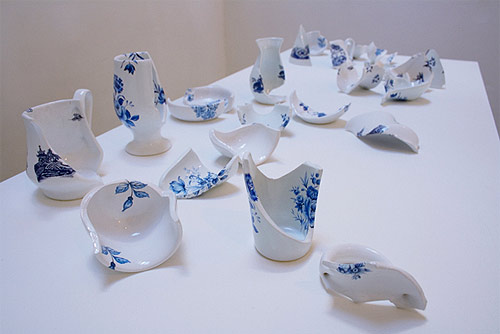
Broken Things, 2009
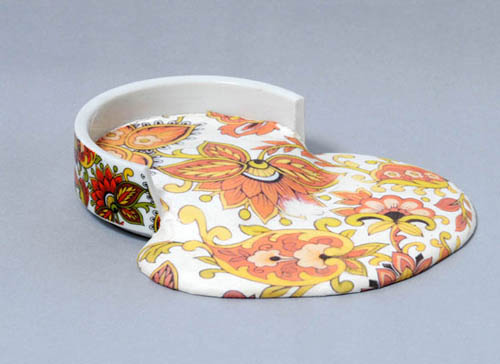
Broken Things, 2009
Broken Things again takes the familiar and separates it from it's usual context. Marin explains the purpose of the exhibit by saying, "In this particular show, the figure of something broken is what hinges that relationship: when something breaks it goes out of use, it can be discarded, but it might enter a new phase of signification if its owner has a strong attachment to it. It’s that moment of decision or indecision that interests me and that I try to recreate by building the object as an ambiguous figure. Within this, it is important that I have worked with mass-produced, non-noble objects, whereby things that were not important in the first place achieve a value or significance by the attachments that people form with them." (http://www.itsnicethat.com/articles/2084-livia-marin-broken-things)
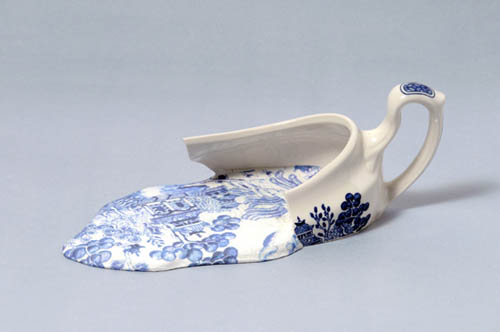
Broken Things, 2009
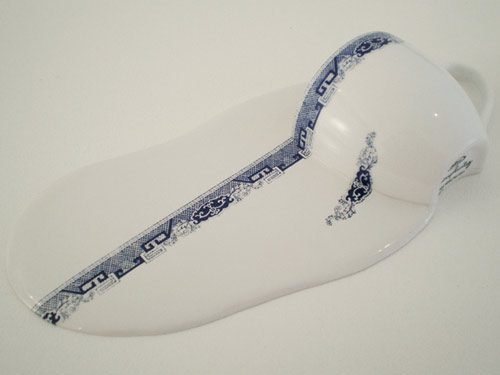
Broken Things, 2009

Ficciones de un uso, 2,214 lipsticks, 2004
In Ficciones de un uso, Marin uses a staggering 2,214 tubes of lipstick to create an installation that is unified through repetition yet manages to reveal an unexpected individuality between pieces. No two lipsticks are the same color or shape. It seems to be a subtle commentary on the way women attempt to find individuality for themselves while still conforming to the homogenizing standard of beauty that is expected of them.

Broken Things, 2009

Broken Things, 2009
Broken Things again takes the familiar and separates it from it's usual context. Marin explains the purpose of the exhibit by saying, "In this particular show, the figure of something broken is what hinges that relationship: when something breaks it goes out of use, it can be discarded, but it might enter a new phase of signification if its owner has a strong attachment to it. It’s that moment of decision or indecision that interests me and that I try to recreate by building the object as an ambiguous figure. Within this, it is important that I have worked with mass-produced, non-noble objects, whereby things that were not important in the first place achieve a value or significance by the attachments that people form with them." (http://www.itsnicethat.com/articles/2084-livia-marin-broken-things)

Broken Things, 2009

Broken Things, 2009
Monday, February 14, 2011
Featured Artist: Janine Antoni
Janine Antoni's art has taken on many forms from transforming everyday objects such as bars of soap or chocolate into busts of herself to performance art such as painting a floor with hair dye using her own hair as a brush. Always, however, there is a focus on the process.

Photo taken from Loving Care performance, 1993

Loving Care, 1993
Loving Care was a performance piece that featured Antoni getting down on her hands and knees and painting an entire floor in hair dye, using her own hair as a paintbrush. Though the meaning of the piece is subjective, one can detect themes of feminism, a love/hate relationship with beauty or beautification processes, determination, and simply the presence of the human body in art.

Lick and Lather, 7 soap and 7 chocolate self-portrait busts, 1993
Process and the presence of the human body are two themes that seem to run through Antoni's work. In Lick and Lather, she alters the familiar process of creating a self-portrait by licking the chocolate busts and washing with the soap busts until details begin to be worn away. Again, a love/hate relationship with body image can be seen, as Antoni slowly erases herself from her work.

Saddle, Full rawhide, 2000
In Saddle, the presence of human body is obvious in the shape of the cowhide, yet the piece is hollow, transparent. It's as if a ghost dwells withing the hide, the sentiment of death echoing the death of the cow that was necessary in order to create the work.

Moor, Handmade rope made by materials donated to the artist by friends and family, 290 feet, 2001

Moor, 2001

Antoni spinning fibers for Moor
Moor is an excellent example of Antoni's focus on the artistic process. The massive rope is made of materials donated from her family and friends, all spun together by the artist. The piece seems to be about connections: the connections between the artist and the people in her life, the connections between her and the feminine tradition of spinning, and finally the connections between stages of life, of history.

Photo taken from Loving Care performance, 1993

Loving Care, 1993
Loving Care was a performance piece that featured Antoni getting down on her hands and knees and painting an entire floor in hair dye, using her own hair as a paintbrush. Though the meaning of the piece is subjective, one can detect themes of feminism, a love/hate relationship with beauty or beautification processes, determination, and simply the presence of the human body in art.

Lick and Lather, 7 soap and 7 chocolate self-portrait busts, 1993
Process and the presence of the human body are two themes that seem to run through Antoni's work. In Lick and Lather, she alters the familiar process of creating a self-portrait by licking the chocolate busts and washing with the soap busts until details begin to be worn away. Again, a love/hate relationship with body image can be seen, as Antoni slowly erases herself from her work.

Saddle, Full rawhide, 2000
In Saddle, the presence of human body is obvious in the shape of the cowhide, yet the piece is hollow, transparent. It's as if a ghost dwells withing the hide, the sentiment of death echoing the death of the cow that was necessary in order to create the work.

Moor, Handmade rope made by materials donated to the artist by friends and family, 290 feet, 2001

Moor, 2001

Antoni spinning fibers for Moor
Moor is an excellent example of Antoni's focus on the artistic process. The massive rope is made of materials donated from her family and friends, all spun together by the artist. The piece seems to be about connections: the connections between the artist and the people in her life, the connections between her and the feminine tradition of spinning, and finally the connections between stages of life, of history.
Friday, February 11, 2011
Featured Artist: James Turrell
James Turrell draws upon his experience in perceptual psychology and optical illusions to create art that focuses on space, perception, and light. His works are wordless, build entirely on visual perception and feeling. He says, “I want to create an atmosphere that can be consciously plumbed with seeing...like the wordless thought that comes from looking in a fire.”

His works challenge his audience by forcing them to wait, to become consciously aware of themselves looking. The works are meant to be taken in slowly, quietly, and over time. I see this as a subtle protest to the way current society rushes about, never taking time to slow down and observe the intricacies and beauty of the things around us.
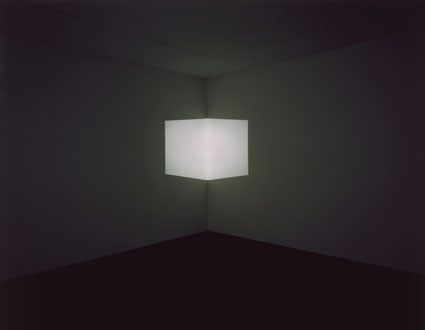
Afrum (White), 1966
Afrum uses light projectors to create the illusion of a floating cube in the corner of two walls. The experience of the piece relies upon the position of the viewer in relation to the projection; some vantage points appear more convincing than others, yet there is a magic in the way that something so tangible could be created with light alone. Turrell once said, “In working with light, what is really important to me is to create an experience of wordless thought, to make the quality and sensation of light itself really quite tactile.”

The Light Inside, Light Installation, 2000
Other works often control their viewers' perception of light by enclosing them inside a structure. An example of such a work is Meeting, one of his Skyspace pieces. Inside this closed room are benches that allow viewers to sit and look up at the sky through an opening in the ceiling. The work focuses on the changing light at sunset and the way in which that light affects emotion.

Meeting, 1986

Meeting, 1986

Viewers looking up at Meeting
Turrell's most ambitious work is still in progress: a celestial observatory created in the center of Roden Crater, near Flagstaff, Arizona. David Cohen described the work as "a multimillion dollar earthwork of tunnels, elliptical chambers, and a perfected rim-- it is designed for enhanced contemplation of the heavens, a kind of natural telescope that will use the laws of perception in lieu of lenses." (http://www.orbit.zkm.de/?q=node/311)

Roden Crater

Roden Crater Observatory

Roden Crater Observatory

Skyscape within Roden Crater Observatory

His works challenge his audience by forcing them to wait, to become consciously aware of themselves looking. The works are meant to be taken in slowly, quietly, and over time. I see this as a subtle protest to the way current society rushes about, never taking time to slow down and observe the intricacies and beauty of the things around us.

Afrum (White), 1966
Afrum uses light projectors to create the illusion of a floating cube in the corner of two walls. The experience of the piece relies upon the position of the viewer in relation to the projection; some vantage points appear more convincing than others, yet there is a magic in the way that something so tangible could be created with light alone. Turrell once said, “In working with light, what is really important to me is to create an experience of wordless thought, to make the quality and sensation of light itself really quite tactile.”

The Light Inside, Light Installation, 2000
Other works often control their viewers' perception of light by enclosing them inside a structure. An example of such a work is Meeting, one of his Skyspace pieces. Inside this closed room are benches that allow viewers to sit and look up at the sky through an opening in the ceiling. The work focuses on the changing light at sunset and the way in which that light affects emotion.

Meeting, 1986

Meeting, 1986

Viewers looking up at Meeting
Turrell's most ambitious work is still in progress: a celestial observatory created in the center of Roden Crater, near Flagstaff, Arizona. David Cohen described the work as "a multimillion dollar earthwork of tunnels, elliptical chambers, and a perfected rim-- it is designed for enhanced contemplation of the heavens, a kind of natural telescope that will use the laws of perception in lieu of lenses." (http://www.orbit.zkm.de/?q=node/311)

Roden Crater

Roden Crater Observatory

Roden Crater Observatory

Skyscape within Roden Crater Observatory
Subscribe to:
Posts (Atom)







